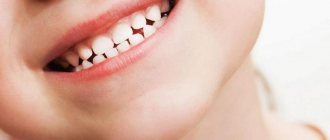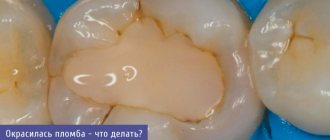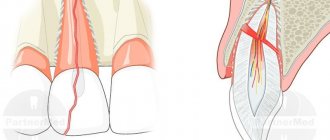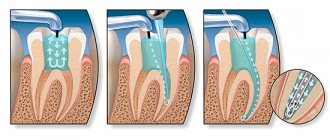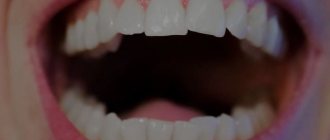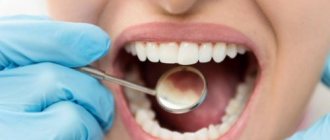Caries is a fairly common dental disease that every person has encountered. This pathological process affects the hard tissues of the teeth, essentially causing their necrosis. Damaged tissues, unfortunately, cannot be restored and require treatment.
Dental caries, like any disease, has its own specific causes. In our case, this pathology is formed by a combination of three factors:
- Carbohydrates,
- Microbes,
- Poor oral hygiene.
The first and second points can be called conditional negative factors, since carbohydrates are an essential component of our diet. Microorganisms, in turn, are an integral part of the flora of the oral cavity, which is impossible and would not be correct to get rid of.
But as for unsatisfactory oral hygiene, this factor is perhaps the key in the formation of caries. Let's explain why. If microbes in combination with carbohydrates come into direct contact with the tooth surface for a long time, they cause local demineralization and subsequently caries. By mechanically cleaning off plaque, in which microorganisms actually live, we interrupt this pathological process and the enamel is again saturated with the minerals contained in saliva. That is why it is necessary not only to regularly, but also to brush your teeth well, mechanically and with a toothbrush.
Brushing your teeth is a prevention of caries, but not a cure. Therefore, when talking about remedies against caries, we tell you how to prevent its formation, but not treat it in any way. After all, there is only one treatment for caries - mechanical removal of the affected tissue using the method of preparation and filling the defect with special materials.
Modern treatment of caries
Thanks to the constant improvement of techniques, today the diagnosis and treatment of dental caries is carried out at a high level, which allows for maximum preservation of healthy tissue. In addition, in situations where just a few years ago advanced caries led to mandatory tooth extraction, today tooth-preserving operations are performed. Among them are the following.
- Resection:
treatment of tooth root caries by removing the apex of the root. - Root amputation:
removal of the damaged root part of a two-rooted or three-rooted tooth. - Coronoradicular separation:
separation of tooth roots. It is carried out when caries has affected the tooth in the area of root branching. - Hemisection:
removal of the damaged part of a multi-rooted tooth and the adjacent crown area.
What are dental fissures
There are fissures on both baby teeth and permanent teeth.
These are physiological folds - grooves, dimples and depressions - on the chewing surface of molars and premolars. The incisors and canines do not have fissures. Such cavities easily and quickly fill with plaque, are poorly cleaned with toothpaste and a brush - they become a common cause of carious lesions. Pediatric dentists often suggest sealing fissures - creating a thin film on the surface of the crown that will protect against pathogenic microflora and mechanical damage.
There are two main reasons for fissure sealing:
- Children's inability to take good care of their teeth. Even the most responsible child is not able to clean all the cavities on the surface of molars and premolars, which leads to the development of caries and the need for treatment. Especially if the grooves differ in depth and tortuosity.
- Thin enamel of teeth - milk and permanent during the period of change of bite. The thickness of the enamel of temporary units is half that of permanent ones, which explains its rapid destruction and susceptibility to caries. During eruption, molars are especially vulnerable - initially the crowns are covered with thin, slightly mineralized enamel, and only after 2-3 years the surface becomes resistant to external damage.
Rodikova Tatyana
Before recommending invasive fissure sealing to a patient, I always look at the initial level of mineralization. With a high mineral content and wide grooves, sealing cavities can be easily done without sealing, but there are cases (low mineralization, prone to caries) when sealing the teeth is the best option!
Indications for the treatment of dental caries
Indications are reduced to visual and tactile.
✔
Visual:
stains on the enamel, darkening of the cervical area of the tooth, chipping of part of the tooth and darkening underneath it, a dark border around the perimeter of the filling, a carious hole.
✔
Tactile:
aching pain when eating sweet, salty and sour foods, and acute pain from sudden temperature changes.
Recommendations
Doctors agree that tooth decay can be prevented and stopped. To prevent caries, you can use a brush that your doctor recommends. It should not be too hard or soft; it is best to choose the middle option, which will not leave scratches or cause pain. It is important not to forget that any brush should be changed every 2-3 months, as well as after suffering from infectious and cold diseases.
If you use toothpaste containing fluoride, it is very important not only to brush your mouth for several minutes, but also to rinse it. This guarantees maximum penetration of beneficial components into the enamel structure. When choosing a paste, it is best to give preference to more expensive formulas, since they contain an element called sodium aminofluoride. As a result, the effectiveness of the impact will be much higher.
As additional care, you can purchase a rinse aid, irrigator, brushes, threads and other useful devices. Their action is aimed at preventing the accumulation of food particles between the teeth. As a result, plaque does not form on the enamel, and cariogenic microorganisms do not multiply. However, you should not use such products on an ongoing basis, as this can lead to disruption of the normal microflora of the oral cavity.
previous post
Treatment of gingival caries
next entry
Types of caries by localization
fissure
It begins in the physiological recesses of the chewing teeth - fissures. The patient cannot detect it during self-examination.
Approximal (or contact)
It begins on the contacting surfaces of adjacent teeth. As a rule, this is a consequence of not using floss or irrigator as part of hygiene.
Cervical
It begins at the base of the gum, gradually destroying the neck of the tooth. It is the result of severe tartar.
Interior
It begins under the tooth filling if errors were made during its installation.
Under the crown
It begins under the crown if it does not fit tightly to the tooth, causing microscopic food debris to accumulate.
What can cause caries?
Caries occurs due to the proliferation and active activity of harmful microorganisms - bacteria - in the human oral cavity. In order for them to multiply and spoil teeth, a person needs to create an environment favorable for them.
It is possible to create ideal conditions for the reproduction and vital activity of pathogenic organisms in the following cases:
- oral and dental care is not performed or hygiene measures are carried out incorrectly;
- a person consumes too much sweets, drinks coffee and carbonated drinks;
- the body does not receive enough calcium, vitamins and essential microelements;
- a person has problems with the gastrointestinal tract;
- eating too hot or cold food.
Caries can occur even on completely healthy teeth. Bacteria multiply in the mouth very quickly and if you do not fight them, you can lose several teeth at once. A small hole forms in the tooth, then pain begins and the process spreads to the remaining teeth.
It is better to prevent the occurrence of caries than to try to treat something later, because it will be better for the person in any case.
Types of caries according to severity
Initial caries
Characterized by a change in the color of the enamel: the so-called white spot caries. Does not cause discomfort to the patient.
Superficial caries
Characterized by the appearance of dark spots on the enamel. The affected tooth may react weakly to cold, sour or sweet foods for a short time.
Average caries
Characterized by destruction of dentin. Painful sensations to external stimuli are more pronounced and last longer.
Deep caries
Characterized by damage to a large area of tooth enamel and dentin. The pain does not go away without the use of analgesics.
Deep fluoridation
Fluoride is known to be an important element in maintaining dental health. However, until recently, the only way to replenish this element in the enamel was toothpaste with fluoride. But its effectiveness is very low, and teeth are still susceptible to destruction. The lack of fluoride is especially felt by residents of those regions where there is a lack of it in drinking water and food.
Today, medicine offers a unique method for restoring tooth enamel and hard tooth tissues - deep fluoridation. This procedure replenishes mineral deficiencies, reduces tooth sensitivity and prevents the growth of bacteria that leads to tooth decay. For children, deep fluoridation is of particular importance, since the formation of permanent teeth occurs only in the child’s body. Insufficient intake of fluoride from food and irregular oral care can contribute to the premature destruction of tooth enamel. Using the deep fluoridation procedure, you can increase its hardness by 10 times!
What is the deep fluoridation method?
This method is based on a series of chemical reactions: they produce microcrystals of calcium fluoride that fill microcracks in the enamel. The deep fluoridation procedure itself takes place in several successive stages. First, the dentist brushes your teeth with a special paste to remove plaque and tartar. Then, using a jet of air, the teeth are dried and covered with a filling liquid, which “seals” the enamel (highly dispersed calcium fluoride and magnesium fluoride). After this, drying is carried out again and calcium and copper hydroxide are applied. A chemical reaction occurs between the first and second layers, during which microparticles of calcium fluoride are released, which very easily penetrate into the deep layers of enamel. At the same time, copper compounds formed as a result of the reaction have a strong bactericidal effect. Due to the described interaction of elements, anti-caries protection occurs.
When is deep fluoridation recommended?
This procedure is preventative and completely painless. It is aimed at long-term protection against enamel destruction and caries (the effect lasts up to two years). Therefore, it can be recommended to everyone who cares about dental health.
Deep fluoridation is especially useful in the following cases:
- to protect baby teeth in young children
- for teenagers whose bodies undergo changes associated with puberty, during which caries activity increases
- with fluoride deficiency due to poor diet or natural environment
- with increased tooth sensitivity
- with thinning enamel
- before installation and after removing braces
Due to the fact that the effect of deep fluoridation is quite long-lasting, it is enough to undergo the procedure 1-2 times a year. However, despite the obvious benefits of this preventive measure, we should not forget about other ways to take care of dental health: a balanced diet, regular brushing, regular visits to the dentist, and so on.
Modern methods of treating dental caries
Today, there are several methods for treating caries, differing in the degree of surgical intervention - the earlier the degree of development of the disease, the greater the likelihood that it will be possible to get rid of it with few sacrifices.
Modern technologies for treating caries without preparation:
- Remineralization:
a procedure for treating enamel caries, which involves treating the tooth surface with a solution containing fluoride, phosphorus and calcium. The patient is also prescribed a number of medications to take orally. Helps in the treatment of white caries, or caries in the spot stage. - Infiltration:
chemical-mechanical treatment is also a method of treating caries without preparing Icon. It is used for initial caries and only on smooth surfaces or between teeth. First, a gel is applied to the carious area, which splits the affected enamel; the site of bacterial development is dried under the influence of ethyl alcohol and an air stream and treated with a polymer resin, which fills the enamel pores. The entire procedure lasts about fifteen minutes. - Air abrasive treatment:
“knocking out” superficial caries using a powerful stream of abrasive particles. The force of action is designed to affect only soft tissues affected by bacteria. The method is painless, and therefore there is no need for anesthesia. Air abrasive treatment reduces the risk of microcracks forming after treatment, in some cases it is even more effective than a drill. However, this method of caries treatment is not always applicable. - Ozone treatment:
destruction of caries bacteria using a natural antibiotic and oxidizing agent - ozone. Another method of non-contact treatment of caries. Ozone not only suppresses infection, but also has a remineralizing effect on tissue. During the procedure, a special device converts ozone from oxygen and supplies it to the affected area. Ozone destroys bacteria and is converted back into oxygen. The technology for treating caries with ozone allows you to leave healthy cells intact. Another advantage is that there is no need for anesthesia. The treatment time for caries using this method is less than a minute. Like the previous one, it is suitable only in the initial stages of caries or as its prevention. - ART technique:
restorative therapy, during which, using a special instrument, the affected tissue is removed and the cavity is filled with special dental cement. This method of treating caries was invented in third world countries, where it was not possible to open full-fledged dental offices, but it is also used in developed countries. Completely manual work allows you to act carefully and preserve as much healthy tissue as possible. - Laser treatment:
an effective technique for eliminating superficial and intermediate caries (for example, in the treatment of dentin caries) using laser fluorescence. During the procedure, a bactericidal solution is used, which cools the tooth and reduces pain. In addition, laser devices do not produce vibrations, which could increase pain. That is why the laser treatment method is indicated primarily for children and pregnant women. The laser selectively acts on the affected area, “evaporating” it, and disinfects the resulting cavity, thus eliminating the risk of developing secondary caries. - Treatment of dental caries with diet:
a method of treating caries naturally, developed based on the scientific theory of the American researcher Ramiel Nagel. According to his observations, caries does not have an infectious-bactericidal nature, but is associated with the weakening and destruction of enamel due to a lack of necessary substances. Therefore, the problem can be solved with proper nutrition. Adherents of natural treatment recommend actively using cod liver, fish caviar, butter and other products containing fat-soluble vitamins, nutritious broths, as well as chicken, beef and fish. It is better not to overuse fruits - due to their high sugar content - and combine them with small portions of fat, such as cream.
How to prevent tooth decay
- Regular brushing of teeth (preferably after every meal). Moreover, you should brush your teeth not an hour or two, but within 5 minutes after eating. It has been proven that food debris and pathogens cause maximum harm to teeth in the first 40 minutes. Is it necessary to brush your teeth after every meal, that is, even after a light snack or tea with candy? Yes, it is necessary, and you need to clearly understand this for yourself. Therefore, you should not overuse snacks during the day.
- Dental floss - This is not an additional tool for cleaning the oral cavity, but is as basic as a toothbrush. Floss must be used in the same way after each meal. For a person who has never used floss before, it may be difficult to understand how to use it - a dentist can help with this. The task of dental floss is to remove food debris between the teeth (caries, no less rarely, develops not only in the tooth cavity, but also between two adjacent teeth).
- What to do if brushing your teeth is problematic (for example, in a cafe or outdoors)? You should always have dental floss or, as a last resort, chewing gum with you. A package of thread does not take up much space, and you can use it by going to the toilet (if we are talking about a room) or stepping aside. Many people are embarrassed to behave this way, as a result, subsequently they will not always have simple and cheap treatment for caries. Embarrassment is inappropriate here: there is nothing shameful in getting up and going to the restroom for a couple of minutes. It’s much better to breathe in freshness afterwards, rather than “delight” those around you with the aromas of a recently eaten lunch.
- Food debris often accumulates under dentures and braces.. People who have crowns in their mouths can be advised to use an irrigator - a device that delivers a stream of water through a special nozzle, saturated with air bubbles and washing away food debris. The device is especially effective for gingivitis and periodontitis, when pockets form where a large number of microbes accumulate. Periodontal pockets are very difficult to clean with a brush or floss, but an irrigator can cope with this task perfectly. The device is also recommended for pregnant women, who often suffer from gingivitis.
In addition to brushing and flossing, the following can help prevent tooth decay:
- strengthening the immune system. A weakened body is not able to fully resist the effects of bacteria. To minimize the risk of developing caries, subject to good hygiene, you need to take care of your immunity through the use of vitamins and hardening;
- properly formulated diet. First of all, you need to reduce the consumption of simple carbohydrates, and also increase the amount of foods containing fluoride and calcium in the menu. We must not forget about regular consumption of hard fruits and vegetables, which cleanse teeth of plaque.
Classical treatment of caries in permanent teeth
In advanced cases, non-invasive treatment methods for caries will not help, so specialists turn to the old but effective removal of caries using drilling.
The procedure involves cleaning the affected canals using a drill; if dentin is damaged, pulp and infected tooth tissue can also be removed. It should be noted that the devices that are used for this today have gone far ahead of those that once brought fear to our grandparents. Anesthesia and disinfectants can reduce the pain effect and make the procedure more comfortable for the patient. To complete the treatment of caries, a filling or crown is placed on the tooth and adjusted so that the patient does not feel any discomfort.
Seal your child’s teeth from caries: how fissure sealing is carried out
Fissure sealing is a painless and short procedure. To carry it out, a “sealant” material, a fissure sealant, is used. Sealant is a high-strength composite composition that hardens under the influence of light. Its feature is increased fluidity, thanks to which the sealant is able to fill even hard-to-reach places on the tooth crown. Also among the advantages of the sealant:
- Waterproof – resistant to saliva.
- Durability – the coating lasts on the teeth for up to 5 years.
- Aesthetics - sealants are produced in transparent, beige, and colored.
Stages of fissure sealing of primary and permanent teeth:
- Removing plaque from enamel and all cavities. Polishing the crown surface.
- Treatment with an antiseptic composition.
- Drying teeth and protecting the treated unit from the influence of saliva.
- Application of acid gel to enhance adhesion and create a slightly rough surface.
- Rinse off the composition and dry the tooth.
- Filling fissures with liquid sealant - applying sealant.
- Creating conditions for hardening - chemical activation or using a light lamp.
- Removing excess material.
- Coating the tooth with a fluoride-containing strengthening gel.
The optimal age of a child for fissure sealing is 6-8 years. During this period, the first permanent molars erupt and need protection. The procedure is indicated for children aged 1.5-2 years, and adolescents aged 12-14 years. The appearance of any wide tooth is a reason to carry out dental sealing and reliably protect the enamel from destruction for several years.
Plaksina Margarita
I am often asked what they cover children's teeth with to protect them from caries. At Aza&Buka we use sealants - special gels. They not only seal the surface of the tooth, but also strengthen the enamel by releasing fluoride ions.
Main stages of the procedure
If for caries in the stain stage, treatment comes down to brushing the teeth with a special brush, applying a remineralizing composition and taking medications to strengthen the enamel, then in later stages it is necessary to remove the affected tissue and fill the cavity. In this scenario, the principle of caries treatment is as follows:
- anesthesia;
- preparation of a carious cavity;
- removal of infected tissue;
- cavity treatment;
- tooth filling.
Caries treatment and filling are carried out in one appointment. If, during the treatment of caries, damage to the dental pulp is detected, it may require its removal.
Choosing a filling
Previously, mainly mineral cements, acrylic and epoxy, and amalgams were used to make fillings. Today, outdated fillings, which were imperfect in terms of fixation and aesthetics, have been replaced by modern inlays. They improve the adhesion strength to the tooth surface, do not require labor-intensive installation, and are biocompatible with the human body. Among them, the most used are: composites, glass ionomer cements, ormocers, compomers. Materials can be combined to achieve the desired effect.
Is it possible to cure tooth decay at home?
Treatment of dental caries at home is impossible. However, this disease is preventable. To do this, you should regularly perform oral hygiene using calcium and fluoride toothpaste, visit the dentist twice a year and ensure that your diet contains enough proteins and fewer carbohydrates. For additional protection, you can apply gels to strengthen tooth enamel, which will saturate the teeth with minerals - they are not a cure for caries, but will help reduce the risk of developing the disease.
If it is too late to prevent caries, then herbal compresses and rinsing with strong tea will help temporarily reduce the intensity of pain. You can also press on the area between the lips and nose - there is a point there, the impact of which will send signals to the brain that distract it from the main source of pain. However, instead of diligently practicing traditional healing, it is better to turn to a professional as soon as possible. After all, only he will help you effectively cope with the problem.
Covering teeth in children: basic methods and their features
Children's teeth are often exposed to such unpleasant and rather dangerous diseases as caries and pulpitis. And not immune from
This is not a single child.
The enamel of a child's tooth is very thin and cannot fully withstand aggressive influences. For example, at night the child ate and fell asleep, and the bacteria ingested with food negatively affect tooth enamel until the morning. This pressure on a child’s teeth over a long period of time causes the development of “bottle caries.” What to do? How to protect your child's teeth? An excellent solution to this problem is offered by dentists at the Beryozka clinic in Balashikha and the medical clinic in Zheleznodorozhny - complete protection of children’s teeth by coating them with special preparations.
Cost of caries treatment in Moscow
The cost of caries treatment in each specific case is calculated individually and consists of several components:
- what type of filling will be installed;
- what type of anesthesia will be used;
- how much work the doctor has to do.
Thus, installing a filling on a chewing tooth affected by caries in state dentistry can cost 900 rubles, since it involves the cheapest composite material. The cost of a light filling in a private dental clinic in Moscow varies between 1500 – 2500 rubles. Treatment of caries of anterior teeth exceeds 3,000 rubles, since there are increased demands on aesthetics. As for anesthesia, local anesthesia starts at 300 rubles per tooth, general anesthesia starts at 2,000 rubles, and treatment with sedation, depending on its degree, ranges from 3,000 to 15,000 rubles.
METHOD 4: SANDMAN air-abrasive dental treatment system
The kinematic system for treating teeth using an air-abrasive method with the SANDMAN system is recognized as the best method for treating teeth without drilling .
It is this technique that the specialists of the Bionic Dentis clinic use in their practice.
This method is based on the fact that a stream of air containing particles of aluminum oxide of a certain caliber acts on the tooth. These particles have such an energy of impact on the tooth tissue that it cleans out the tooth tissue affected by the carious process, but does not injure healthy tooth tissue at all.
Another advantage of the air-abrasive method of tooth preparation without drilling is that there is no need to treat the tooth with acid before installing a light filling.

